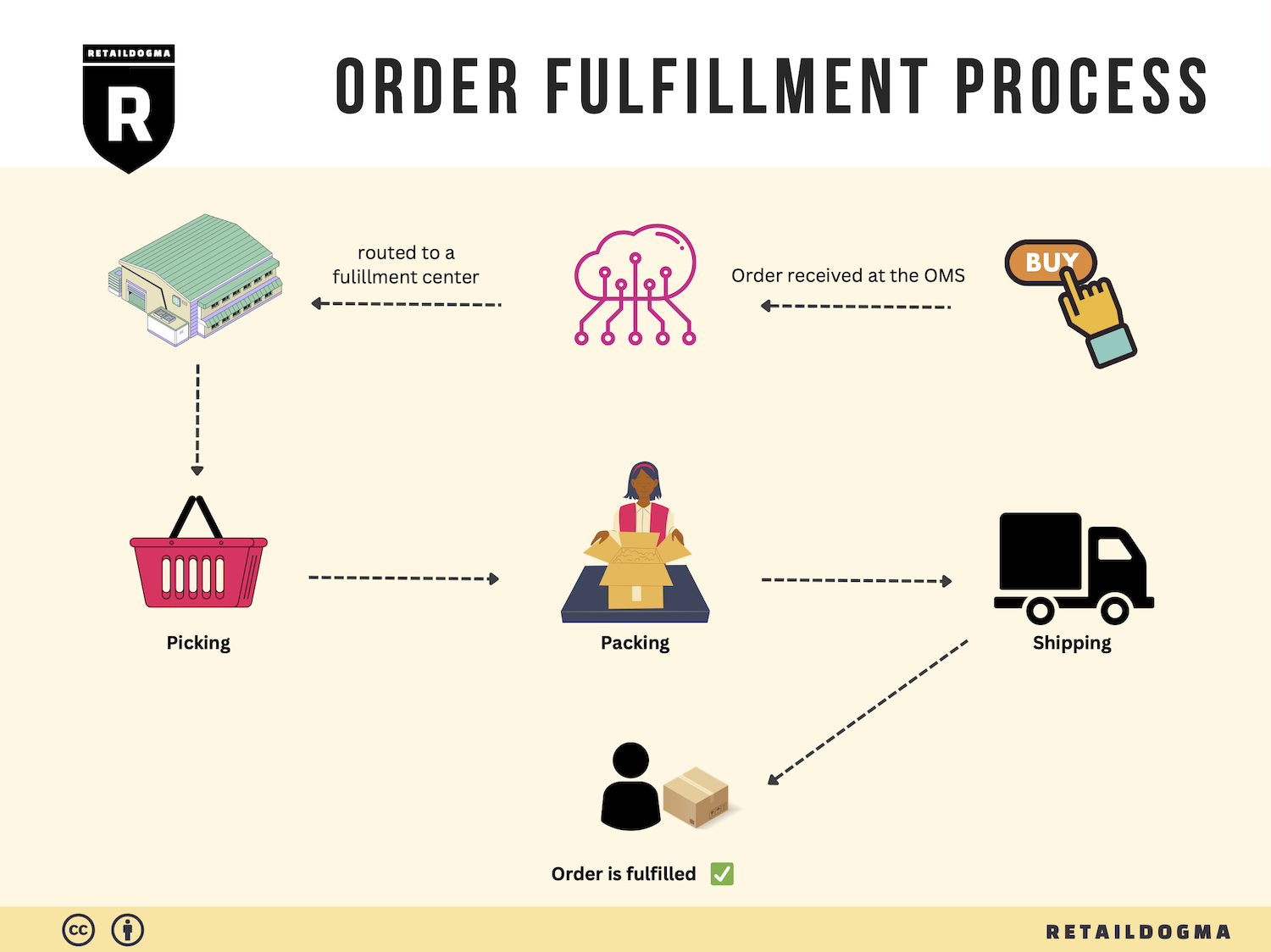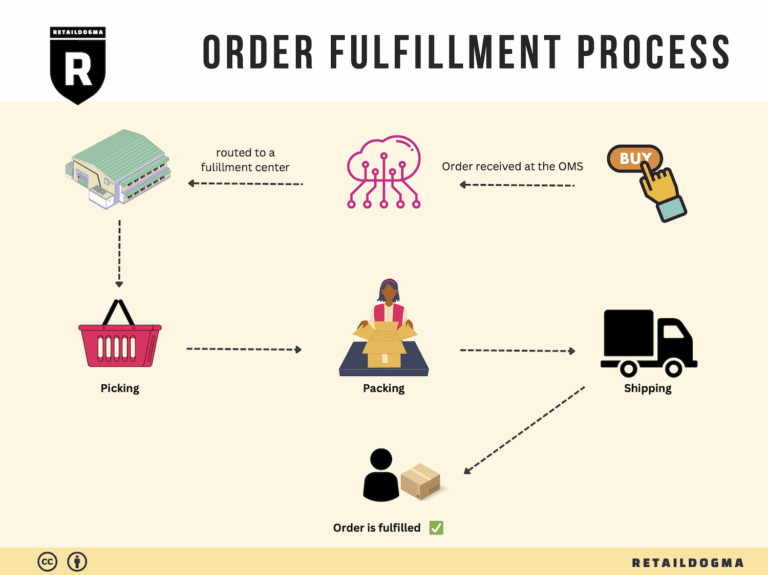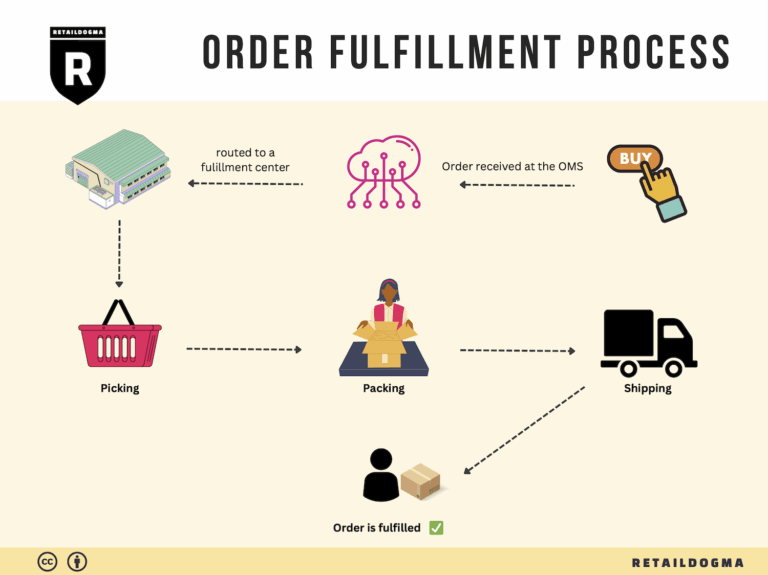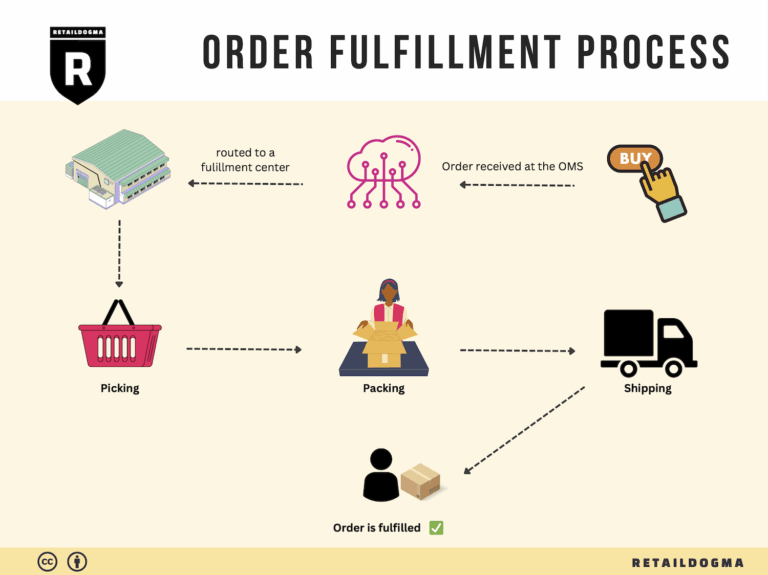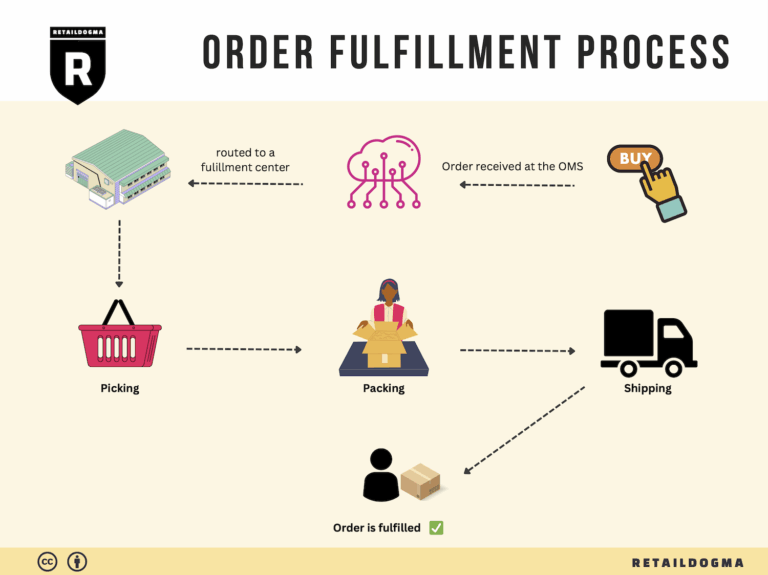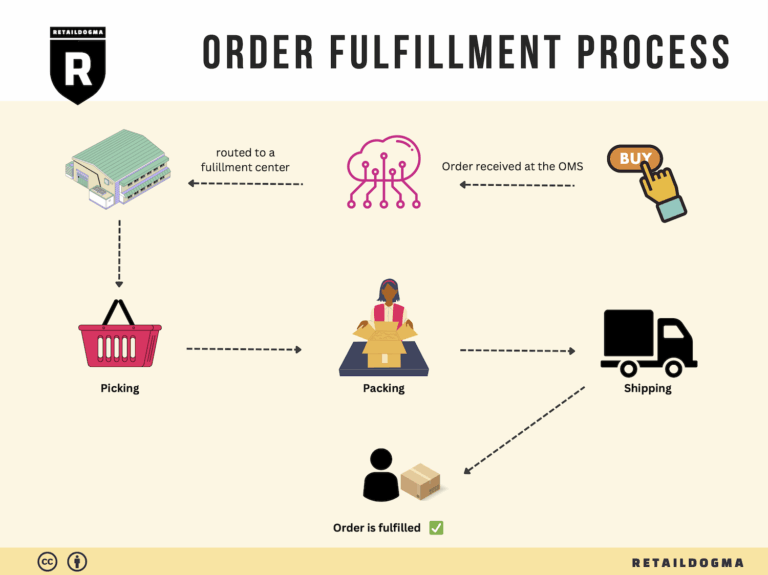How Order Fulfillment Works: A Step-by-Step Guide for Businesses
What is E-commerce Fulfillment? An Introduction for Growing Businesses
Understanding E-commerce Fulfillment
As an e-commerce business owner, you may find yourself overwhelmed with the intricacies of packing and shipping orders. The excitement of growing your sales often brings the daunting challenge of efficiently delivering products to your customers. This is where e-commerce fulfillment comes into play—a crucial process that ensures your products reach customers swiftly and accurately.
At its core, fulfillment is the entire process of getting a product from your warehouse (or store) to the customer’s doorstep. This includes receiving inventory, processing orders, picking and packing products, and finally shipping them out. As your business scales, the complexities of fulfillment can increase significantly. Understanding the different fulfillment models available, such as Third-Party Logistics (3PL) and Fulfillment by Amazon (FBA), can help you choose the right solution for your needs.
In this guide, we will explore the various fulfillment models that can support your growth. You’ll learn about the core services these models offer, including inventory management, order processing, and shipping logistics. We will also discuss how to select the right fulfillment partner tailored to your specific business requirements. Factors such as location, service quality, and technological capabilities are vital considerations when making this choice.
Another critical aspect we will cover is pricing. Understanding the cost structure associated with different fulfillment options is essential for maintaining your profit margins while ensuring customer satisfaction. We will break down common pricing models and help you identify what to expect based on your volume of sales and specific logistics needs.
The ultimate goal of this guide is to empower you to make informed, strategic decisions about your logistics operations. By gaining a clear understanding of e-commerce fulfillment, you can streamline your processes, enhance customer satisfaction, and focus on what matters most—growing your business. Whether you are just starting out or looking to scale your operations, the insights provided here will serve as a valuable resource in navigating the complexities of fulfillment.

What You’ll Learn In This Guide
- What is E-commerce Fulfillment? An Introduction for Growing Businesses
- The Order Fulfillment Process: From ‘Buy’ Button to Customer’s Door
- Comparing Fulfillment Models: In-House vs. 3PL vs. Dropshipping
- A Deep Dive into Amazon FBA: Pros, Cons, and Who It’s For
- Core Services Offered by Fulfillment Centers
- How to Choose a Fulfillment Partner: A 6-Point Checklist
- Understanding Fulfillment Pricing: A Breakdown of Common Fees
- Frequently Asked Questions (FAQs) about Fulfillment
- Conclusion: Is Outsourcing Fulfillment the Right Move for Your Business?
- Important Disclaimer
The Order Fulfillment Process: From ‘Buy’ Button to Customer’s Door
1. Receiving Inventory
The order fulfillment process begins with receiving inventory, a critical step that sets the foundation for efficient operations. When products arrive at the fulfillment center, they undergo a thorough inspection to ensure they match the purchase orders. This involves verifying quantities and checking for any damage or discrepancies. A key term associated with this step is SKU (Stock Keeping Unit), a unique identifier for each product that helps track inventory levels and streamline management.
The importance of this step cannot be overstated. Accurate receiving minimizes errors that could cascade through the fulfillment process, leading to customer dissatisfaction. An efficient receiving process allows businesses to maintain optimal stock levels, reducing the risk of stockouts or excess inventory, which can tie up capital.
2. Warehouse Storage
Once inventory is received and verified, it is then stored in designated locations within the warehouse. The organization of this storage is vital for maximizing space and ensuring quick access to products. Modern fulfillment centers often utilize sophisticated Warehouse Management Systems (WMS) to categorize and store items efficiently.
Effective warehouse storage is crucial for several reasons. It enhances the speed of order fulfillment by reducing the time it takes to locate products. Moreover, a well-organized warehouse can significantly improve labor productivity, as employees spend less time searching for items. Additionally, maintaining an organized storage system helps in managing inventory turnover and optimizing storage costs.
3. Order Picking
The next step in the fulfillment process is order picking, where items are retrieved from storage to fulfill customer orders. This step often employs pick lists, documents that outline which items need to be collected and in what quantities. Depending on the fulfillment center’s size and technology, various picking methods may be used, including single order picking, batch picking, or zone picking.
Order picking is critical because it directly impacts order accuracy and speed. Errors in this stage can lead to incorrect shipments, resulting in returns and customer dissatisfaction. Implementing efficient picking strategies, such as using mobile scanning devices, can greatly enhance accuracy and speed, ultimately leading to a better customer experience.

4. Order Packing
After items are picked, they move to the packing station, where they are prepared for shipment. This step involves placing products in appropriate packaging, labeling them correctly, and including any necessary documentation, such as invoices or return labels. A key term related to this stage is packaging optimization, which refers to the process of selecting the right box size and packing materials to minimize shipping costs and protect products during transit.
Order packing is essential for ensuring that products arrive at their destination in perfect condition. Well-packed orders reduce the risk of damage during shipping, which can lead to costly returns and unhappy customers. Additionally, efficient packing processes can decrease shipping costs, improve delivery speed, and enhance overall operational efficiency.
5. Shipping & Delivery
The final step in the order fulfillment process is shipping and delivery, where packed orders are handed over to carriers for transportation to customers. This stage involves generating shipping labels, selecting the appropriate carriers, and ensuring compliance with shipping regulations. A crucial aspect of this step is last-mile delivery, which refers to the final leg of the delivery journey from a distribution center to the customer’s doorstep.
Shipping and delivery are pivotal in shaping the customer experience. Timely and accurate delivery can significantly enhance customer satisfaction and loyalty. Moreover, optimizing shipping routes and methods can help reduce costs and improve delivery times, crucial for businesses looking to scale. Understanding and leveraging various shipping options, including express and standard shipping, allows businesses to meet diverse customer needs effectively.
In conclusion, mastering the order fulfillment process is vital for e-commerce businesses aiming to scale. Each step—receiving inventory, warehouse storage, order picking, order packing, and shipping & delivery—plays a vital role in ensuring operational efficiency and customer satisfaction. By focusing on optimizing these processes, businesses can enhance their logistics capabilities and ultimately drive growth.
Comparing Fulfillment Models: In-House vs. 3PL vs. Dropshipping
Fulfillment Model Comparison
| Model | Who Handles Inventory | Best For (Business Stage) | Key Advantage | Key Disadvantage |
|---|---|---|---|---|
| In-House Fulfillment | Business itself | Established businesses with stable demand | Full control over inventory and fulfillment process | High overhead costs and resource-intensive |
| Third-Party Logistics (3PL) | External logistics provider | Growing businesses needing flexibility | Scalable solutions and reduced operational burden | Less control over inventory management and fulfillment |
| Dropshipping | Supplier or manufacturer | Startups and small businesses | Low upfront investment and minimal risk | Lower profit margins and reliance on supplier reliability |
In-House Fulfillment
In-house fulfillment is a model where a business manages its inventory and shipping processes internally. This approach is typically favored by established businesses that have reached a stable demand level and have the resources to handle logistics. The primary advantage of in-house fulfillment is the control it provides over inventory management and the overall fulfillment process. Businesses can optimize storage, pick, pack, and ship operations according to their specific needs, ensuring a tailored customer experience. However, this model comes with significant drawbacks, including high overhead costs associated with warehousing, labor, and technology investments. Additionally, as order volumes fluctuate, businesses may find themselves over- or under-resourced, impacting efficiency and customer satisfaction.
Third-Party Logistics (3PL)
Third-party logistics (3PL) involves outsourcing the warehousing and fulfillment process to an external logistics provider. This model is ideal for growing businesses that need scalable solutions without the burden of managing logistics in-house. The key advantage of using a 3PL provider is the ability to focus on core business activities while leveraging the expertise and infrastructure of the logistics partner. 3PLs offer flexibility, allowing businesses to scale operations up or down based on demand fluctuations, which is especially beneficial during peak seasons. However, a notable disadvantage is the reduced control over inventory management and the fulfillment process, which can lead to inconsistencies in service quality and customer experience if the 3PL does not meet expectations. Furthermore, reliance on a third-party provider can introduce risks related to communication and coordination.
Dropshipping
Dropshipping is a fulfillment model where the retailer does not keep products in stock but instead transfers customer orders directly to a supplier or manufacturer, who then ships the products to the customer. This model is particularly appealing to startups and small businesses due to its low upfront investment and minimal operational risk. Since retailers do not have to invest in inventory upfront, they can offer a wide range of products without the associated costs of storage and handling. However, dropshipping also has its downsides. Profit margins tend to be lower compared to other fulfillment models, as retailers often pay wholesale prices for products. Additionally, the reliance on suppliers for inventory management and shipping can lead to issues with order fulfillment, such as delays or stock shortages, which can harm customer satisfaction and brand reputation. Retailers must also invest in building strong relationships with reliable suppliers to mitigate these risks.
In summary, each fulfillment model presents unique advantages and challenges. Businesses must carefully evaluate their operational capabilities, market demands, and long-term goals to determine the most suitable fulfillment strategy for their needs. Understanding the nuances of in-house fulfillment, 3PL, and dropshipping can help e-commerce entrepreneurs make informed decisions that align with their business objectives.
A Deep Dive into Amazon FBA: Pros, Cons, and Who It’s For
Understanding Fulfillment by Amazon (FBA)
Fulfillment by Amazon (FBA) is a service offered by Amazon that enables e-commerce sellers to store their products in Amazon’s fulfillment centers. When a customer places an order for a product, Amazon takes care of storage, packaging, shipping, and customer service on behalf of the seller. This service has become increasingly popular among e-commerce business owners seeking to streamline their logistics and enhance their sales reach.
How FBA Works
-
Product Preparation: Sellers prepare their products according to Amazon’s guidelines, ensuring they are properly packaged and labeled.
-
Shipping to Amazon: Once the products are ready, sellers ship them to one or more of Amazon’s fulfillment centers. Amazon provides a shipping plan that indicates where to send the products.
-
Storage: The products are stored in Amazon’s warehouses until sold. Sellers are charged storage fees based on the amount of space their products occupy.
-
Order Fulfillment: When a customer orders a product, Amazon picks, packs, and ships the item directly to the customer. This process is highly automated and efficient, utilizing advanced technology and robotics.
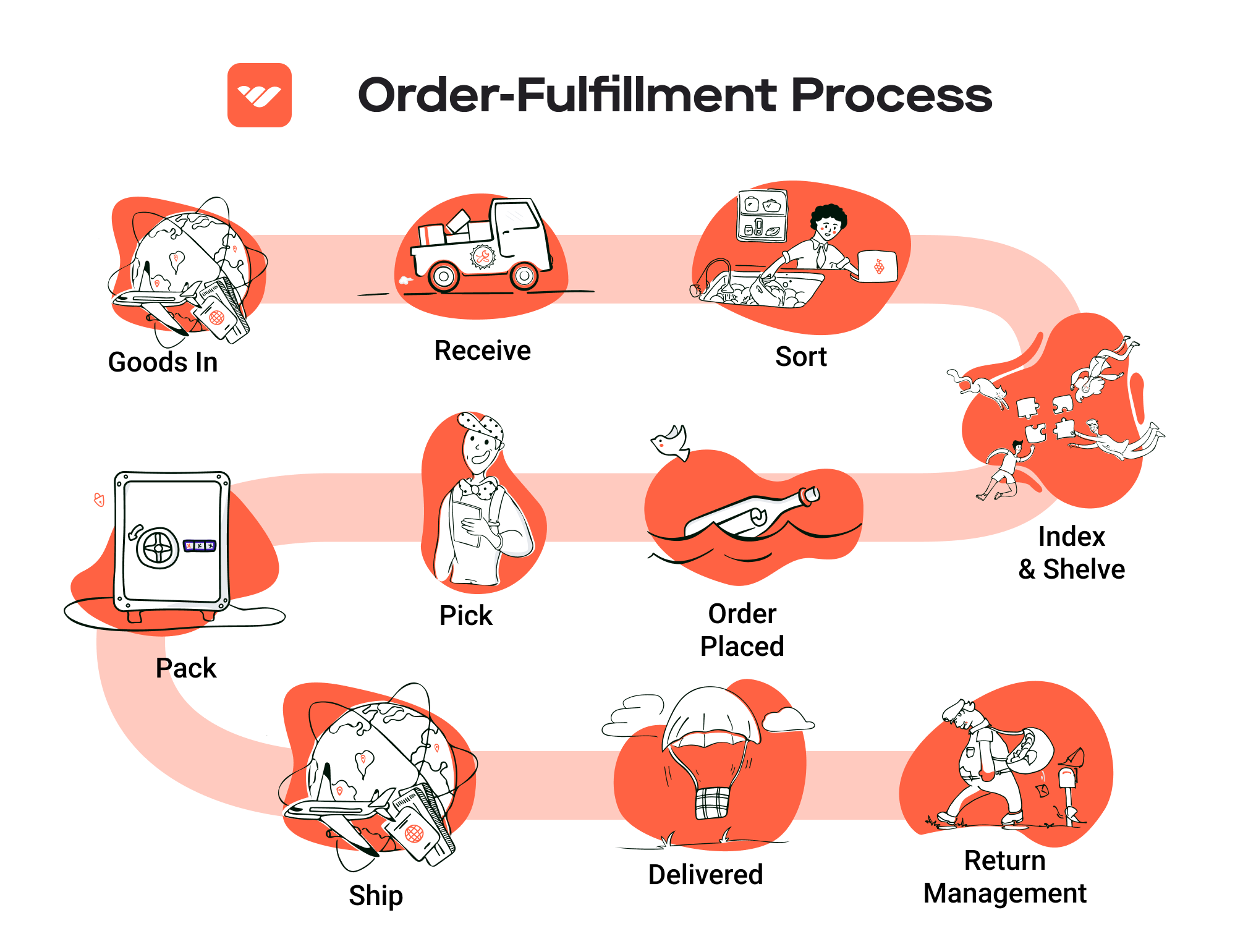
-
Customer Service and Returns: Amazon handles all customer service inquiries and return requests, providing a hassle-free experience for sellers.
-
Payment: After a sale, sellers receive payment minus Amazon’s fees, which include referral fees and fulfillment fees.
Pros of Using FBA
Prime Eligibility
One of the most significant advantages of using FBA is eligibility for Amazon Prime. Products fulfilled by Amazon are listed with the Prime logo, making them more appealing to a large base of Prime members who prioritize fast and free shipping. This can lead to increased sales and better visibility in search results.
Customer Trust
Products fulfilled by Amazon benefit from Amazon’s established reputation. Customers tend to trust Amazon’s logistics and customer service, leading to higher conversion rates. When customers see that a product is fulfilled by Amazon, they may feel more confident in their purchase decision, knowing they are backed by Amazon’s return policies and customer support.
Multi-Channel Fulfillment
FBA is not limited to Amazon’s marketplace. Sellers can utilize FBA for orders placed on other platforms, such as their own e-commerce websites or other marketplaces. This flexibility allows sellers to centralize their inventory and streamline their shipping processes, making it easier to manage logistics across multiple sales channels.
Cons of Using FBA
High Fees
While FBA offers numerous benefits, it also comes with costs that can add up quickly. Sellers are charged fulfillment fees for each unit sold, as well as monthly storage fees based on the volume of inventory stored in Amazon’s warehouses. During peak seasons, such as the holiday season, storage fees can significantly increase, impacting profit margins.
Strict Inventory Rules
Amazon has stringent inventory management rules that sellers must adhere to. This includes limitations on certain products, requirements for labeling and packaging, and rules regarding inventory performance metrics. Sellers must continuously monitor their inventory levels to avoid long-term storage fees and potential removal of their products from Amazon’s platform.
Commingling Risks
When sellers choose to use FBA, their products may be commingled with those of other sellers. This means that when a customer orders a product, they might receive an item that has been fulfilled by another seller. This can lead to issues such as receiving damaged goods or counterfeit items, which can negatively impact a seller’s reputation and lead to negative reviews.
Who is FBA Best For?
Fulfillment by Amazon is best suited for e-commerce business owners and entrepreneurs who are looking to scale their operations without the burden of managing logistics. Specifically, FBA is ideal for:
-
Small to Medium-Sized Businesses: Companies that lack the resources to handle their own warehousing and shipping can benefit from Amazon’s extensive infrastructure.
-
Sellers with High Sales Volume: Businesses that anticipate high sales volumes can leverage FBA to manage order fulfillment efficiently and maintain customer satisfaction.
-
Brands Looking to Expand Reach: Companies aiming to enhance their brand visibility and reach a broader audience can take advantage of Amazon’s massive customer base and trust.
-
Multi-Channel Sellers: Businesses selling on multiple platforms can streamline their logistics by utilizing FBA for all their fulfillment needs, thus allowing them to focus on marketing and product development.
In conclusion, Fulfillment by Amazon offers a compelling option for e-commerce sellers seeking to enhance their operational efficiency and customer experience. While it comes with its own set of challenges, the benefits of FBA, such as Prime eligibility and customer trust, make it a valuable tool for businesses looking to scale. By carefully weighing the pros and cons and understanding the unique needs of their operations, sellers can make informed decisions about whether FBA is the right choice for them.
Core Services Offered by Fulfillment Centers
Inventory Management & Warehousing
Fulfillment centers provide comprehensive inventory management and warehousing services that are crucial for e-commerce businesses. These centers are designed to store a vast array of products efficiently. They utilize advanced inventory management systems that allow businesses to track stock levels in real-time, ensuring that they always have the right products on hand to meet customer demand.
One of the primary benefits of effective inventory management is the reduction of excess stock and associated costs. By monitoring inventory levels closely, fulfillment centers can help businesses avoid overstocking items that may not sell, thus freeing up capital for other investments. Additionally, real-time data on inventory can enhance forecasting accuracy, allowing businesses to make informed decisions about purchasing and restocking.
Moreover, warehousing in fulfillment centers is often optimized for space and accessibility, which minimizes the time and effort required to retrieve products when orders are placed. This efficiency translates to faster order processing times, ultimately leading to improved customer satisfaction and loyalty.
Pick and Pack Services
The pick and pack service is a cornerstone of fulfillment center operations. This process involves selecting products from the warehouse shelves (picking) and then packaging them for shipment (packing). Fulfillment centers employ trained staff and sophisticated technology, such as barcode scanners and automated systems, to ensure accuracy and speed during this process.
For e-commerce businesses, the pick and pack service offers significant advantages. First, it allows for scalability; as a business grows, fulfillment centers can easily handle increased order volumes without the need for the business to invest in additional labor or technology. This flexibility is essential for businesses experiencing seasonal spikes in demand or rapid growth.
Additionally, efficient pick and pack services can enhance order accuracy, reducing the likelihood of shipping errors that can lead to returns or customer dissatisfaction. Quick and precise fulfillment not only ensures a better customer experience but also strengthens brand reputation, which is vital in today’s competitive e-commerce landscape.
Kitting and Assembly
Kitting and assembly services offered by fulfillment centers involve combining multiple products into a single package or preparing items for sale. This may include assembling products that require some degree of assembly before shipping or creating promotional kits that bundle related items together.
The main benefit of kitting and assembly is the enhanced customer experience. By providing ready-to-ship kits or assembled products, businesses can offer convenience to their customers, making it easier for them to purchase multiple items at once. This can lead to increased average order value as customers are more likely to buy bundled products.
Furthermore, kitting allows businesses to streamline their operations. Instead of managing the assembly process in-house, which can be time-consuming and labor-intensive, companies can leverage the expertise and resources of fulfillment centers. This not only saves time but also reduces the overhead costs associated with maintaining a workforce for assembly tasks.
Returns Management (Reverse Logistics)
Returns management, often referred to as reverse logistics, is a critical service that fulfillment centers offer to e-commerce businesses. This process involves handling product returns efficiently and effectively, ensuring that returned items are processed and resold when possible.
The importance of effective returns management cannot be overstated. A smooth returns process enhances customer satisfaction, as consumers today expect hassle-free returns. Fulfillment centers can provide automated return processing systems that allow customers to initiate returns easily, print labels, and track their return status. This level of service can differentiate a business from its competitors and foster customer loyalty.
Moreover, fulfillment centers are equipped to assess returned items and determine their resale potential. By efficiently processing returns and restocking products that are still in sellable condition, businesses can minimize losses and recoup some of their investment. This capability is essential for maintaining healthy profit margins, especially in a retail environment where returns are commonplace.
In conclusion, fulfillment centers offer a suite of core services that are vital for scaling e-commerce businesses. From efficient inventory management to precise pick and pack operations, kitting services, and robust returns management, these centers play an integral role in enhancing operational efficiency and customer satisfaction. By leveraging these services, e-commerce businesses can focus on growth and innovation while leaving the logistics to the experts.
How to Choose a Fulfillment Partner: A 6-Point Checklist
Location & Warehouse Network
Importance: The geographical location of your fulfillment partner can significantly affect shipping times, costs, and customer satisfaction. A partner with a well-distributed network of warehouses can help you reach your customers faster and more efficiently.
Questions to Ask:
– Where are your fulfillment centers located?
– How do your locations align with our target market?
– What shipping options do you offer (e.g., standard, expedited, same-day)?
– Can you provide insights into your average shipping times for different regions?
Technology & Integrations
Importance: In today’s e-commerce landscape, technology plays a crucial role in streamlining operations. An ideal fulfillment partner should have robust technology that integrates seamlessly with your existing systems (like your e-commerce platform) to manage inventory, orders, and shipping efficiently.
Questions to Ask:
– What technology platforms do you use for inventory management and order processing?
– Can your systems integrate with our e-commerce platform (e.g., Shopify, WooCommerce, Amazon)?
– What kind of reporting and analytics do you provide?
– How do you handle updates and maintenance of your technology?
Specializations (e.g., cold storage, oversized items)
Importance: Not all fulfillment partners can handle every type of product. If your business deals with specialized items—such as perishable goods requiring cold storage or large, bulky items—you need to ensure your partner has the capabilities to manage these effectively.
Questions to Ask:
– Do you have any specializations in your fulfillment services?
– What types of products are you equipped to handle (e.g., fragile, oversized, temperature-sensitive)?
– Can you accommodate seasonal demand fluctuations for specialized items?
– What certifications or standards do you meet for handling specialized products?
Scalability & Capacity
Importance: As your business grows, your fulfillment needs will change. A suitable partner should be able to scale with your business, providing additional capacity during peak seasons without compromising service quality.
Questions to Ask:
– What is your current capacity, and how do you handle peak seasons?
– How quickly can you scale up operations if our demand increases suddenly?
– Are there any limitations on the volume of orders you can handle?
– What is your process for onboarding new clients and ramping up fulfillment operations?
Pricing and Contracts
Importance: Understanding pricing structures and contract terms is essential to avoid unexpected costs that can impact your margins. A transparent pricing model allows you to budget effectively and plan for future expenses.
Questions to Ask:
– What is your pricing structure (e.g., per order, per item, monthly fees)?
– Are there any additional costs (e.g., storage fees, pick-and-pack fees, shipping surcharges)?
– Can you provide a detailed breakdown of all potential costs?
– What are the contract terms, and is there flexibility for renegotiation?
Customer Support & Reviews
Importance: Reliable customer support is vital for resolving issues quickly and maintaining a smooth operation. Additionally, checking reviews from other clients can provide insights into the partner’s reliability and service quality.
Questions to Ask:
– What support channels do you offer (e.g., phone, email, chat)?
– What are your typical response times for customer support inquiries?
– Can you provide references or case studies from similar businesses?
– How do you handle customer complaints and operational issues?
Conclusion
Choosing the right fulfillment partner is a critical decision that can significantly impact your business operations and customer satisfaction. By following this checklist and asking the right questions, you can make an informed choice that aligns with your business goals and growth trajectory. Remember, the right partner will not only meet your current needs but also adapt to your evolving requirements as you scale.
Understanding Fulfillment Pricing: A Breakdown of Common Fees
Initial Setup Fees
When partnering with a fulfillment center, the initial setup fees are typically the first costs you encounter. These fees can vary significantly based on the complexity of your operations and the services required. Initial setup fees generally cover the costs associated with onboarding your products into the system, including inventory registration, software integration, and account setup.
This fee may also include training your staff on using the fulfillment center’s systems, especially if they are unique to the provider. To ensure you understand the full scope of initial setup fees, request a detailed breakdown that specifies what is included. Some providers might offer promotional waivers for these fees, so it’s beneficial to inquire about potential discounts or bundled services.
Receiving Fees
Receiving fees are charged when your inventory arrives at the fulfillment center. This fee compensates the facility for unloading, inspecting, and storing your products. The calculation of receiving fees can depend on various factors, including the volume of goods being received and the complexity of the receiving process.
For instance, if your items require special handling or if you are sending bulk shipments, expect higher receiving fees. Many fulfillment centers charge based on the number of pallets or units received, so it’s crucial to have an accurate estimate of your incoming inventory to avoid unexpected costs. When negotiating with fulfillment providers, ask about their receiving process and how fees are structured to gain clarity.
Storage Fees (per pallet/bin)
Storage fees are incurred for keeping your inventory in the fulfillment center. These fees are typically calculated on a per pallet or per bin basis and can vary based on the duration of storage. Most fulfillment centers charge on a monthly basis, with the cost often decreasing per pallet as volume increases.
It’s essential to understand how storage fees may change with seasonal fluctuations in inventory. For example, if you expect to store more products during peak seasons, negotiate a tiered storage fee structure that accommodates your business cycles. Additionally, be aware of potential minimum storage fees that could apply even if your inventory volume is low.
Pick & Pack Fees (per item/order)
Pick and pack fees cover the cost of selecting items from your inventory and packing them for shipment. This fee is usually charged on a per item or per order basis. The complexity of your orders can influence these fees; for instance, if your products require special packaging or if orders frequently contain multiple items, the fees may increase.
Fulfillment centers may also offer different pricing tiers based on the level of service, such as standard packing versus custom packaging. To optimize your costs, consider streamlining your inventory to reduce the number of unique SKUs and simplify the picking process. When discussing pick and pack fees, clarify how they calculate charges and whether there are any additional fees for special requests.
Shipping Fees
Shipping fees are one of the most variable costs associated with fulfillment services. These fees are determined by the size and weight of your packages, the shipping method selected, and the destination. Most fulfillment centers leverage their shipping volume to negotiate discounted rates with carriers, which can benefit you as a client.
To effectively manage shipping costs, it’s crucial to understand how the fulfillment center calculates shipping fees and whether they charge handling fees in addition to carrier costs. Additionally, consider the fulfillment center’s shipping options, including express versus standard shipping, as this can significantly affect your bottom line. By choosing a fulfillment partner that offers competitive shipping rates, you can enhance your overall profitability.
Tips for Getting an Accurate Quote
To ensure you receive an accurate quote from a fulfillment center, follow these practical steps:
-
Provide Detailed Information: Be clear about your product specifications, inventory turnover rates, and expected order volumes. The more data you provide, the more precise the quote will be.
-
Inquire About All Fees: Ask for a comprehensive breakdown of all potential fees, including any hidden or additional charges that may not be immediately apparent.
-
Discuss Seasonal Variations: If your business experiences seasonal fluctuations, discuss how this will impact your fulfillment needs and costs.
-
Request a Custom Quote: Many fulfillment centers offer personalized quotes based on your unique business needs. Don’t hesitate to ask for this option.
-
Compare Multiple Providers: Finally, don’t settle for the first quote you receive. Compare offers from multiple fulfillment centers to ensure you find the best value for your business.
By understanding these common fulfillment pricing models and following these tips, you can better navigate the complexities of fulfillment fees and select a provider that aligns with your business goals.
Frequently Asked Questions (FAQs) about Fulfillment
1. What is an Amazon Fulfillment Center?
An Amazon Fulfillment Center is a large warehouse where Amazon stores products and processes orders for customers. Unlike traditional warehouses, fulfillment centers utilize advanced technology, including robotics and conveyor systems, to efficiently pick, pack, and ship products. This allows for rapid order processing and delivery, enhancing the customer experience.
2. How do Amazon Fulfillment Centers differ from traditional warehouses?
The primary difference lies in their operational efficiency and technology integration. Traditional warehouses primarily focus on storage, while fulfillment centers are designed for rapid order fulfillment. They employ advanced technology, such as automated robots and sophisticated inventory management systems, to streamline the process of picking, packing, and shipping orders.
3. What can I expect during an Amazon Fulfillment Center tour?
During a tour, you can expect to see the inner workings of a fulfillment center, including the use of robots and conveyor belts, the layout of storage areas, and the order processing workflow. Tours typically last between 45-90 minutes and provide insights into how Amazon manages its logistics and supply chain operations.
4. What is a 3PL, and how does it relate to fulfillment?
A 3PL, or third-party logistics provider, is a company that manages logistics and supply chain functions for other businesses. This can include warehousing, transportation, and fulfillment services. Many e-commerce businesses partner with 3PLs to leverage their expertise and infrastructure, allowing them to focus on core business activities while ensuring efficient order fulfillment.
5. How much do fulfillment services cost?
Fulfillment service costs can vary widely depending on factors such as order volume, storage space, packaging, and shipping methods. Generally, fees include storage fees (per cubic foot), picking and packing fees (per order), and shipping costs. Businesses should evaluate multiple providers to understand pricing structures and find a solution that aligns with their budget and operational needs.
6. What should I wear for the Amazon Fulfillment Center tour?
To ensure safety and compliance with Amazon’s dress code, visitors should wear flat, closed-toed shoes (no sandals or high heels) and long pants. Shirts must have sleeves, and visitors should avoid loose clothing or accessories that could pose safety risks. It’s advisable to arrive dressed appropriately to avoid being turned away at the entrance.
7. Are children allowed on the fulfillment center tours?
Yes, children are welcome to participate in the tours; however, there are specific age restrictions. Children must be at least 6 years old and must be accompanied by an adult. For every 10 minors, at least one adult must supervise. Safety is paramount, and all minors must adhere to the same dress code and safety regulations as adult participants.
8. How do I register for a tour of the MDW7 Fulfillment Center?
To register for a tour, you must sign up in advance through the Amazon Tours website. Walk-ins are not permitted. Ensure that your registration details match your government-issued photo ID, which will be required upon arrival. Tours can fill up quickly, so it’s advisable to book as early as possible.
9. What items are not allowed during the tour?
Visitors are prohibited from bringing cell phones, bags, and outside food or drinks into the fulfillment center. You may carry a transparent water bottle, keys, and your wallet. If you have essential items that cannot be left behind, Amazon provides a secure location to store them during the tour.
10. Can I take photos during the tour?
Photography is generally restricted within the fulfillment center. Cell phones are not allowed, and photography is only permitted in designated areas, such as the lobby. This policy is in place to protect proprietary processes and ensure the safety of all visitors and employees.
Conclusion: Is Outsourcing Fulfillment the Right Move for Your Business?
Evaluating the Advantages of Outsourcing Fulfillment
As e-commerce continues to evolve, many business owners are faced with the pivotal decision of whether to outsource their fulfillment processes. Leveraging a fulfillment service can yield substantial benefits that can significantly enhance your operational efficiency and overall growth trajectory.
One of the most compelling advantages of outsourcing fulfillment is time savings. By entrusting your logistics to a specialized partner, you free up valuable resources that can be redirected towards core business activities such as product development, marketing, and customer engagement. This shift not only optimizes your operational workflow but also allows you to focus on strategic initiatives that drive revenue.
Scalability is another critical benefit. As your business grows, so do the complexities of order management and shipping logistics. A fulfillment partner can easily adapt to fluctuations in demand, enabling you to scale operations seamlessly. Whether you experience seasonal peaks or rapid growth due to successful marketing campaigns, a robust fulfillment service can accommodate these changes without the need for substantial investments in infrastructure.
Moreover, outsourcing fulfillment grants you access to industry expertise and advanced technologies. Fulfillment centers like Amazon’s employ cutting-edge systems and automation tools, such as robotics and sophisticated inventory management software, which can enhance accuracy and speed in order processing. This expertise can lead to improved customer satisfaction, as orders are fulfilled more efficiently and accurately.
However, the success of outsourcing hinges on selecting the right fulfillment partner. Conduct thorough research to ensure that your chosen provider aligns with your business goals and can scale alongside you.
Take Action
Now is the time to evaluate your current shipping and fulfillment processes. Conduct an audit to identify inefficiencies and explore whether partnering with a fulfillment service could be your next strategic move. By doing so, you position your business for sustained growth and enhanced customer satisfaction.
Important Disclaimer
⚠️ Important Disclaimer
The information in this guide is for educational purposes. Fulfillment services, pricing, and platform features change frequently. Always conduct your own due diligence and consult with providers directly before making business decisions.
